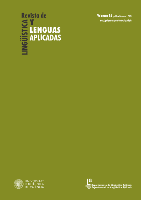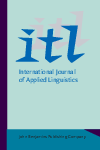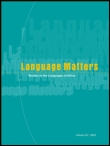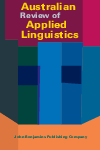
Journal of Research in Applied Linguistics
Scope & Guideline
Pioneering New Paths in Linguistic Research
Introduction
Aims and Scopes
- Language Teaching and Learning:
The journal focuses on methodologies and practices in language education, exploring how different teaching strategies impact learners' language acquisition and proficiency. - Cultural and Social Contexts of Language:
It examines how language interacts with cultural and social factors, including identity construction, politeness strategies, and the influence of digital communication. - Technology in Language Education:
The journal addresses the role of technology in language learning and teaching, including online courses, digital tools, and innovative pedagogical approaches. - Research Methodology in Applied Linguistics:
It emphasizes empirical research methods in applied linguistics, providing insights into research design, data collection, and analysis within the field. - Multilingualism and Cross-Cultural Communication:
The journal investigates issues related to multilingualism, language policy, and cross-cultural interactions, highlighting the complexities of communication in diverse linguistic environments.
Trending and Emerging
- Digital Pedagogy and Online Learning:
There is a notable increase in research related to online language education, particularly in the context of the COVID-19 pandemic, highlighting the challenges and opportunities of digital teaching environments. - Identity and Language:
Themes exploring the relationship between language and identity construction are gaining traction, particularly in multicultural and multilingual contexts, indicating a growing interest in sociolinguistic factors. - Innovative Assessment and Teacher Development:
Emerging studies focus on innovative assessment methods and professional development for language teachers, showcasing the importance of continuous learning and adaptation in the field. - Critical Approaches to Language and Power:
Research examining the interplay between language, power dynamics, and social justice is trending, reflecting a broader societal concern with equity and representation in language use. - Transmodal and Transcultural Communication:
There is an increasing focus on transmodal meaning-making and transcultural reception, emphasizing how language interacts with various modes of communication and cultural interpretations.
Declining or Waning
- Traditional Linguistic Analysis:
There appears to be a reduced emphasis on traditional linguistic analyses, such as detailed grammatical studies or purely theoretical frameworks, as the journal increasingly prioritizes applied and empirical approaches. - Static Language Education Models:
Research centered around fixed or traditional models of language education is becoming less prominent, with a growing preference for dynamic, technology-integrated, and context-aware teaching methodologies. - Narrowly Defined Language Skills:
Topics focusing solely on isolated language skills (e.g., grammar drills or vocabulary memorization) are less frequently published, as the journal shifts towards holistic approaches that integrate multiple language competencies.
Similar Journals

Revista de Linguistica y Lenguas Aplicadas
Exploring the Dynamics of Language and CommunicationRevista de Linguistica y Lenguas Aplicadas, an esteemed journal published by UNIV POLITECNICA VALENCIA, EDITORIAL UPV, is a pivotal resource in the field of linguistics and applied languages. Since its inception, the journal has embraced Open Access publishing since 2006, ensuring that its rich repository of research is readily available to a global audience of researchers, academics, and language professionals. Headquartered in Valencia, Spain, the journal contributes significantly to the advancement of linguistics knowledge, boasting a respectable ranking within the Q3 quartile for Linguistics and Language (2023) according to Scopus metrics. It covers a diverse range of topics and methodologies, engaging readers through its commitment to scholarly rigor and innovation. The journal is uniquely positioned to inform and inspire essential discussions from 2015 to 2024, making it a vital platform for emerging linguists and seasoned scholars alike, as they explore the evolving landscapes of language and communication.

Annual Review of Applied Linguistics
Driving discussions in the dynamic field of linguistics.The Annual Review of Applied Linguistics, published by Cambridge University Press, stands as a premier journal in the realm of linguistics and psychology, with an impressive impact factor identifying its significance: ranking in the Q1 quartile across both fields in 2023. With an ISSN of 0267-1905 and an E-ISSN of 1471-6356, this journal endeavors to provide comprehensive and insightful reviews covering an array of topics within applied linguistics, thus supporting researchers, professionals, and students in advancing their understanding and expertise. Operating from its base in Cambridge, United Kingdom, the journal has maintained a consistent commitment to scholarly excellence since its inception, accelerating discussions on critical issues and emerging research trends from 2005 to 2024. Notably, it holds a prestigious position in Scopus, ranked #26 in Language and Linguistics and #30 in Social Sciences, showcasing its influence and contribution to the scholarship in the field. The Annual Review of Applied Linguistics thus stands as an essential resource for anyone engaged in linguistic research and application.

Canadian Journal of Applied Linguistics
Empowering Educators with Cutting-Edge Linguistic ResearchCanadian Journal of Applied Linguistics is a premier, peer-reviewed publication dedicated to the field of applied linguistics, encompassing a wide range of topics related to language acquisition, language assessment, teaching methodologies, and sociolinguistics. Published by the ASSOC CANADIENNE LINGUISTIQUE APPLIQUEE, this Open Access journal has been paving the way for innovative research and insightful discourse in the linguistic community since 1998. With its comprehensive insights and scholarly articles, the journal serves as an invaluable resource for researchers, educators, and students alike, facilitating the exchange of ideas and advancements in applied linguistics. The journal is committed to promoting quality research that enhances our understanding of language-related processes in diverse contexts, making it a significant contributor to the global dialogue in linguistics. Based in Ottawa, Canada, the journal is accessible to a wide audience, reflecting its dedication to inclusivity and knowledge sharing in the thriving field of applied linguistics.

Suvremena Lingvistika
Empowering Language Research Through Open Access.Suvremena Lingvistika is a distinguished open-access journal published by the Croatian Philological Society, dedicated to advancing research in the field of linguistics and language. Since its establishment, the journal has been pivotal in promoting scholarly dialogue within the linguistics community, especially among researchers and academics in Croatia and beyond. With an ISSN of 0586-0296 and an E-ISSN of 1847-117X, the journal has transitioned to an open-access model since 2007, ensuring that research is freely accessible to all. As of 2023, it holds a respectable Q3 ranking in the Linguistics and Language category, reflecting its potential contribution to the field. The journal's scope encompasses a wide array of linguistic disciplines, encouraging both theoretical and empirical studies. Supportive of new research, Suvremena Lingvistika aims to foster innovative approaches and methodologies in linguistics, making it an essential resource for students, researchers, and professionals eager to explore the complexities of language. With its ongoing publication until 2024, it continues to shape the linguistic landscape, providing valuable insights and fostering collaboration among scholars globally.

Colombian Applied Linguistics Journal
Fostering dialogue through innovative linguistic research.Colombian Applied Linguistics Journal, published by UNIV DISTRITAL FRANCISCO JOSE DE CALDAS, serves as a vital platform for the advancement of knowledge in the field of applied linguistics, particularly within the Latin American context. Since its inception in 2003, the journal has embraced an Open Access model, ensuring that cutting-edge research is readily accessible to scholars, practitioners, and students alike. With a focus on topics including language acquisition, language policy, and bilingual education, the journal contributes to the understanding of linguistic diversity and its practical applications in educational settings. The Colombian Applied Linguistics Journal is dedicated to fostering dialogue and disseminating research that bridges theory and practice, thus playing a crucial role in shaping contemporary discourses in linguistics and education. Located in Bogotá, Colombia, the journal encourages submissions from both national and international authors, enhancing its reputation as a key player in the global linguistic community.

APPLIED LINGUISTICS
Elevating Academic Discourse in LinguisticsApplied Linguistics, published by Oxford University Press, is a premier scholarly journal that has significantly contributed to the fields of linguistics and communication since its inception in 1980. With an impressive impact factor and ranked in the top quartile (Q1) in both Communication and Linguistics and Language categories, Applied Linguistics is recognized for its rigorous peer-reviewed articles that explore the intersections of language, society, and cognition. The journal enjoys a remarkable position in the Scopus rankings, placing it among the top 2% of publications in its discipline. Researchers, professionals, and students benefit from its comprehensive scope, which encompasses innovative research on language acquisition, discourse analysis, and applied linguistics methodologies. Although not an open access journal, its commitment to advancing knowledge and fostering academic discussions makes it an indispensable resource for anyone interested in the critical role of language in various contexts.

RAEL-Revista Electronica de Linguistica Aplicada
Connecting Theory with Practice in LinguisticsRAEL-Revista Electronica de Linguistica Aplicada, published by the ASOC ESPANOLA LINGUISTICA APLICADA-AESLA, is a prominent open access journal that has been serving the field of applied linguistics since its inception in 2002. With a dedicated focus on the interplay between language and its practical applications in various contexts, the journal aims to disseminate high-quality research and foster academic discourse among linguists, educators, and policy makers alike. Based in Spain at the Universidad Politécnica de Valencia, RAEL is indexed in Scopus and offers access to a global readership. With a current impact factor reflecting its esteem in the fields of Education, Linguistics, and Social Sciences, the journal ranks in Q3 for linguistics and has achieved significant positioning within its categories. Researchers and students seeking to explore applied linguistic phenomena will find valuable insights and diverse perspectives in its published articles, making RAEL a vital resource in the pursuit of knowledge advancement in this dynamic discipline.

ITL-International Journal of Applied Linguistics
Championing excellence in applied linguistics research.ITL-International Journal of Applied Linguistics, published by JOHN BENJAMINS PUBLISHING CO in Belgium, stands as a leading journal in the field of applied linguistics and education, recognized for its rigorous scholarship and impactful contributions. With an impressive ranking of Q1 in both the Education and Linguistics and Language categories, ITL holds its place among the top journals globally, featuring in the Scopus rankings with a notable 91st percentile in both Arts and Humanities as well as Social Sciences. The journal aims to disseminate innovative research exploring the intersection of linguistics, language acquisition, and pedagogical practices, fostering a rich academic dialogue among researchers, educators, and practitioners. Though not currently an open access journal, ITL remains accessible to a broad readership, with an emphasis on high-quality, peer-reviewed articles that inform and inspire advancements in applied linguistics. The journal's commitment to academic excellence and relevance makes it an essential resource for those seeking to understand and contribute to the dynamic landscape of language studies.

Language Matters
Transforming Perspectives on Language AcquisitionLanguage Matters is a prestigious journal dedicated to the dynamic field of Linguistics and Language, published by Routledge Journals, Taylor & Francis Ltd in the United Kingdom. With an ISSN of 1022-8195 and an E-ISSN of 1753-5395, this journal serves as an essential platform for scholars seeking to explore the multifaceted relationships between language and society. Recognized in the 2023 Category Quartiles as Q2 in Linguistics and Language, it boasts impressive Scopus rankings, sitting at #298 out of 1088 in the Arts and Humanities category and #356 out of 1167 in Social Sciences, highlighting its significant impact on the field with a 72nd and 69th percentile ranking, respectively. The journal's scope encompasses a wide range of topics including language acquisition, sociolinguistics, and psycholinguistics, making it a vital resource for researchers, educators, and students alike. By not offering open access, it maintains a curated selection of high-quality peer-reviewed articles, ensuring that academic rigor and relevance are upheld for its readership. With a publication range spanning from 1993 to 2024, Language Matters continues to shape conversations and advance knowledge in the ever-evolving landscape of linguistic research.

Australian Review of Applied Linguistics
Innovating Insights at the Intersection of Language and PracticeAustralian Review of Applied Linguistics is a premier scholarly journal published by John Benjamins Publishing Co, dedicated to advancing the field of applied linguistics through high-quality research. With an ISSN of 0155-0640 and an E-ISSN of 1833-7139, this journal serves as a vital resource for researchers, educators, and practitioners interested in the intersection of language, linguistics, and real-world applications. Situated in the top quartile of Q1 in Linguistics and Language for 2023, it holds an esteemed position within both the Arts and Humanities and Social Sciences sectors, ranking in the 87th and 86th percentiles, respectively. The journal welcomes contributions that address diverse linguistic issues, offering insights that can influence policy, pedagogy, and practice. Although it does not currently offer open access options, the Australian Review of Applied Linguistics remains committed to disseminating impactful research, fostering academic discourse, and enriching the field until 2024 and beyond. While the journal started in 2006, its ongoing publication reflects a commitment to continuous engagement with emerging trends and developments in applied linguistics.